What is it about?
Enterococci possess interesting properties not only for the food industry, but also for animal and human health. The antimicrobial potential of these bacteria includes principally bacteriocin-like molecules. With the aim of identifying bacteriocinogenic strains, a collection of 300 enterococci isolated from different origins were screened and their spectrum of action, as well as the gene encoding the bacteriocin, was determined. Fifty-nine bacteriocin-producing Enterococcus showed high activity against Listeria monocytogenes and Paenibacillus larvae, the causative agent of American foulbrood. Enterocins A, P and L50A/B were found in various combinations.
Featured Image
Why is it important?
The most important finding of this study is the growth inhibition of P. larvae due to bacteriocin-producing Enterococcus, which opens up the possibility to use these strains to control the disease in honeybees.
Perspectives
Biotechenological application of our results
Mohamed Salah Abbassi
Institute of veterinary research of Tunisia
Read the Original
This page is a summary of: High inhibition of Paenibacillus larvae
and Listeria monocytogenes
by Enterococcus
isolated from different sources in Tunisia and identification of their bacteriocin genes, Letters in Applied Microbiology, March 2014, Oxford University Press (OUP),
DOI: 10.1111/lam.12239.
You can read the full text:
Contributors
The following have contributed to this page










